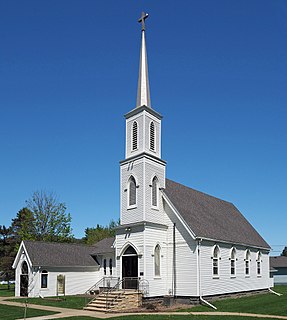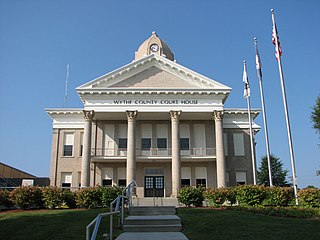
Renner is an unincorporated community in Minnehaha County in the U.S. state of South Dakota. Renner has been assigned the ZIP code of 57055. The demographics of Renner are not listed separately by the United States Census Bureau, but are included within those of Mapleton Township. The 2000 Census reported a total population of 2,128 for all of Mapleton Township.

Carpenter Gothic, also sometimes called Carpenter's Gothic or Rural Gothic, is a North American architectural style-designation for an application of Gothic Revival architectural detailing and picturesque massing applied to wooden structures built by house-carpenters. The abundance of North American timber and the carpenter-built vernacular architectures based upon it made a picturesque improvisation upon Gothic a natural evolution. Carpenter Gothic improvises upon features that were carved in stone in authentic Gothic architecture, whether original or in more scholarly revival styles; however, in the absence of the restraining influence of genuine Gothic structures, the style was freed to improvise and emphasize charm and quaintness rather than fidelity to received models. The genre received its impetus from the publication by Alexander Jackson Davis of Rural Residences and from detailed plans and elevations in publications by Andrew Jackson Downing.

Gloria Dei Church, known locally as Old Swedes', is a historic church located in the Southwark neighborhood of Philadelphia, Pennsylvania, at 929 South Water Street, bounded by Christian Street on the north, South Christopher Columbus Boulevard on the east, and Washington Avenue on the south. It was built between 1698 and 1700, making it the oldest church in Pennsylvania and second oldest Swedish church in the United States after Holy Trinity Church in Wilmington, Delaware.

Holy Trinity Church, also known as Old Swedes, is a historic church at East 7th and Church Street in Wilmington, Delaware. It was consecrated on Trinity Sunday, June 4, 1699, by a predominantly Swedish congregation formerly of the colony of New Sweden. The church, designated a National Historic Landmark in 1961, is among the few surviving public buildings that reflect the Swedish colonial effort. The church is considered part of First State National Historical Park. The church, which is often visited by tourists, remains open for tours and religious activities.
Henry C. Dudley (1813–1894), known also as Henry Dudley, was an English-born North American architect, known for his Gothic Revival churches. He was a founding member of the American Institute of Architects and designed a large number of churches, among them Saint Paul's Episcopal Cathedral in Syracuse, New York, built in 1884, and Trinity Church, completed in 1858.

The Church of the Holy Cross is a historic Anglican church at 335 North Kings Highway in Stateburg, South Carolina. Built in 1850-52 to a design by noted South Carolina architect Edward C. Jones, it is a notable example of rammed earth construction with relatively high style Gothic Revival styling. It was designated a National Historic Landmark for its architecture in 1973. In 2013, the Church of the Holy Cross disaffiliated with the Episcopal Church and realigned with the Anglican Church in North America.

Christ Church refers to both an Episcopal parish currently located in Matapeake, Maryland and the historic church building located in the Stevensville Historic District in Stevensville, Maryland, which the parish occupied from 1880 to 1995, and that is now a Lutheran church. Christ Church Parish was one of the original 30 Anglican parishes in the Province of Maryland.
Church of the Holy Comforter may refer to the following churches:

The Church of the Holy Comforter, built in 1860, is a Gothic Revival church located at 18 Davies Place, near the train station in Poughkeepsie, New York, United States, a few blocks from the Hudson River. Its steeples are prominently visible to traffic passing through the city since the construction of the elevated US 9 expressway in 1965.

St. Alban's Episcopal Church is an active parish in the Episcopal Diocese of New York, in the United States. The building is an historic Carpenter Gothic style church now located at 76 St. Alban's Place in Eltingville, Staten Island. It was built in 1865 as the Church of the Holy Comforter at what is now 3939 Richmond Avenue, the present site of the South Shore YMCA, and was designed by Richard Michell Upjohn, the son of the noted Carpenter Gothic architect, Richard Upjohn. In 1873, the building was split in half and moved to its present location, where it was re-assembled and expanded. In 1951, Holy Comforter absorbed the congregation of nearby St. Anne's Episcopal Church, Great Kills, and changed its name to St. Alban's. St. Anne's had been founded in 1929 as an offshoot of Holy Comforter.

This is a list of the National Register of Historic Places listings in Dakota County, Minnesota. It is intended to be a complete list of the properties and districts on the National Register of Historic Places in Dakota County, Minnesota, United States. Dakota County is located in the southeastern part of the U.S. state of Minnesota, bounded on the northeast side by the Upper Mississippi River and on the northwest by the Minnesota River. The locations of National Register properties and districts for which the latitude and longitude coordinates are included below, may be seen in an online map.

St. Philip's Church is an historic church at 142 Church Street in Charleston, South Carolina. Its National Historic Landmark description states: "Built in 1836, this stuccoed brick church features an imposing tower designed in the Wren-Gibbs tradition. Three Tuscan pedimented porticoes contribute to this design to make a building of the highest quality and sophistication." On November 7, 1973, it was added to the National Register of Historic Places and designated a National Historic Landmark.

There are 71 properties listed on the National Register of Historic Places in Albany, New York, United States. Six are additionally designated as National Historic Landmarks (NHLs), the most of any city in the state after New York City. Another 14 are historic districts, for which 20 of the listings are also contributing properties. Two properties, both buildings, that had been listed in the past but have since been demolished have been delisted; one building that is also no longer extant remains listed.

St. Athanasius Episcopal Church and Parish House and the Church of the Holy Comforter is a historic Episcopal church complex located at 300 E. Webb Avenue and 320 E. Davis Street in Burlington, Alamance County, North Carolina.
Hobart Brown Upjohn (1876–1949) was an American architect, best known for designing a number of ecclesiastical and educational structures in New York and in North Carolina. He also designed a number of significant private homes. His firm produced a total of about 150 projects, a third of which were in North Carolina.

Joseph Bell DeRemer (1871–1944), who lived and worked in Grand Forks, North Dakota, was one of the finest architects in North Dakota. Some of the important works produced by him or his firm, which included his son Samuel Teel DeRemer, include the President's House at the University of North Dakota, the Masonic Temple, and the Art Moderne United Lutheran Church and North Dakota State Capitol skyscraper. Joseph DeRemer also designed houses in the Grand Forks Near Southside Historic District, most notably the Tudor Revival house presently located at 521 South Sixth Street off Reeves Drive. His significant works include a number of buildings that are listed on the U.S. National Register of Historic Places.

Trinity Episcopal Church is a historic church building in Stockton, Minnesota, United States, constructed in 1859. It is now the Grace Evangelical Lutheran Church and was enlarged with a new wing in 1971. The original section was listed on the National Register of Historic Places in 1984 for having local significance in the themes of architecture and exploration/settlement. It was nominated for its well-preserved Carpenter Gothic architecture and shared importance to a community established by American-born settlers but later dominated by German immigrants.

Wytheville Historic District is a national historic district located at Wytheville, Wythe County, Virginia. The district encompasses 245 contributing buildings in the historic core of the town of Wytheville. They are primarily residential and commercial buildings and structures dating from about the 1830s to early 1940s. Notable buildings include the Fleming K. Rich House (1830s), Edith Bolling Galt Wilson Birthplace, Ephraim McGavock House (1858), Holy Trinity Lutheran Church (1876), Wytheville AM&O station (1873), Wythe County Courthouse (1902), George Wythe Hotel (1927), Millwald Theatre (1928), Trinkle Mansion, and Wytheville Municipal Building (1929), The Haller-Gibboney Rock House and St. John's Episcopal Church are located in the district and listed separately.

Charlottesville and Albemarle County Courthouse Historic District, also known as the Charlottesville Historic District is a national historic district located at Charlottesville, Virginia. The district encompasses the previously listed Albemarle County Courthouse Historic District and includes 269 contributing buildings and 1 contributing object in the city of Charlottesville. It includes the traditional heart of the city's commercial, civic, and religious activities, with early residential development and industrial sites located along the fringe. The commercial core is located along a seven block Downtown Mall designed by Lawrence Halprin (1916-2009). Notable buildings include the Albemarle County Courthouse, Levy Opera House, Number Nothing, Redland Club, Eagle Tavern, United States Post Office and Courts Building (1906), Christ (Episcopal) Church (1895-1898), Beth Israel Synagogue (1882-1903), Holy Comforter Catholic Church (1925), First Methodist Church (1924), McIntire Public Library (1919-1922), and Virginia National Bank (1916). Also located in the district are the separately listed Abell-Gleason House, William H. McGuffey Primary School, Thomas Jonathan Jackson sculpture, Robert Edward Lee sculpture, and Marshall-Rucker-Smith House.

The Methodist Episcopal Church, also known as the Methodist Episcopal Church of Hibernia, is a historic church built in 1869 and located at 419 Green Pond Road in the Hibernia section of Rockaway Township, Morris County, New Jersey. It was added to the National Register of Historic Places on July 14, 2011, for its significance in architecture and industry. Since 1970, the building has been used as a branch of the Rockaway Township Free Public Library.






















